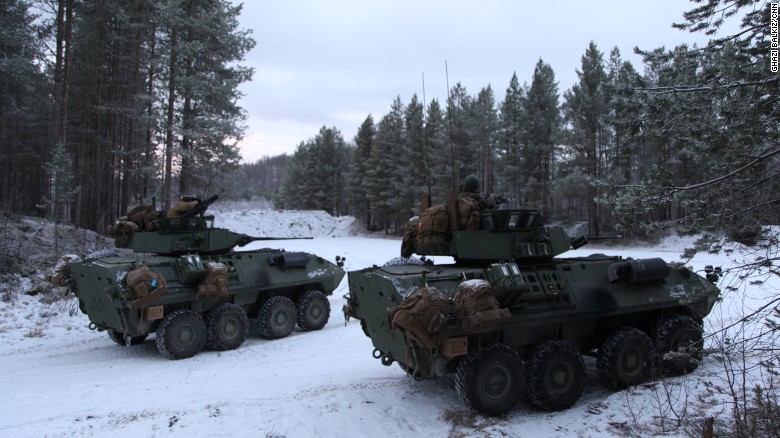US Army releases first climate strategy with goal to reach net-zero greenhouse gas emissions by 2050

US Marines take part in an exercise with Norwegian troops in sub-zero temperatures above the Arctic Circle.
(CNN)The US Army released its first climate strategy on Tuesday with goals to reduce the Army's greenhouse gas pollution by 50% by 2030 and attain "net-zero" emissions by 2050.
The
Army plans to meet these goals by increasing fuel efficiency, making
more Army vehicles electric, modernizing "operational power generation,
battery storage, land management, procurement," and "supply chain
resilience," the report said.
The
strategy comes as Defense Secretary Lloyd Austin has made climate
change and studying its effects within the US military a priority since
taking the helm of the Defense Department. Shortly after being sworn in
as Defense Secretary in January 2021, Austin announced the department
would "immediately" take "appropriate policy actions to prioritize
climate change considerations in" military activities and risk
assessments.
"Climate
change threatens America's security and is altering the geostrategic
landscape as we know it," Secretary of the Army Christine Wormuth said
in the opening statement of the Army's strategy document. "For today's
Soldiers operating in extreme temperature environments, fighting
wildfires, and supporting hurricane recovery, climate change isn't a
distant future, it is a reality."
The US military has been impacted
by extreme weather in the past few years at air force bases, naval
stations and army bases in the continental US. Hurricane Florence in
2018 caused about $3.5 billion in damages and repairs at Camp Lejeune,
North Carolina, and flooding at Offutt Air Force Base in Nebraska caused
about $500 million in damages in 2019, according to a Defense
Department report.
"The
time to address climate change is now. The effects of climate change
have taken a toll on supply chains, damaged our infrastructure, and
increased risks to Army Soldiers and their families due to natural
disasters and extreme weather," Wormuth said.
The
US Army strategy offers a "roadmap of actions" that will make army
bases more prepared "in the face of climate-related threats," a news
release on the report said.
Part
of the strategy involves enhancing "resilience and sustainability" by
"adapting" military infrastructure to be better prepared to face the
potential risks caused by climate change and climate change related
weather events.
This
includes considering climate change and its risks in all aspects of the
Army's development of infrastructure and installations, from "resilient
energy and water supply" to "carbon-pollution-free electricity,
efficient structures," and more, the report states.
Right
now, the US Army has 950 renewable energy projects supplying 480
megawatts of power, and there are 25 microgrid energy projects planned
through 2024. The Army plans to install a microgrid on every Army
installation by 2035, the report states.
The
Army is moving towards carbon-pollution-free electricity production
with the goal of using 100% pollution-free electricity on Army
installations by 2030. They are moving towards purchasing electricity
from carbon-pollution-free sources to meet this goal, the report states.
The
strategy also includes ways to improve sustainability on army
installations, reduce "sustainment demand" and prepare the Army with
"skills, concepts and plans necessary to operate in a climate-altered
world," the release about the report said.



No comments